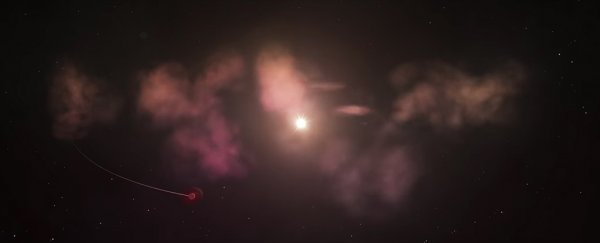A strange "winking" star called RZ Piscium could be devouring the remains of busted planets, according to new research, solving a long-standing mystery around the star's age and surrounding activity.
Using 11 hours of telescope readings, astronomers have established that RZ Piscium is a young-ish star, similar to our own Sun – but given that it's a toddler in star terms, it shouldn't have as much dust and debris around it as the observations show.
That's where the idea of eating up planet fragments comes in. The team of researchers suggest one or more planets recently disintegrated in the RZ Piscium system, or are still being formed, and the star is feasting on the leftovers.
"Our observations show there are massive blobs of dust and gas that occasionally block the star's light and are probably spiraling into it," says one of the team, Kristina Punzi from the Rochester Institute of Technology (RIT) in New York.
"Although there could be other explanations, we suggest this material may have been produced by the break-up of massive orbiting bodies near the star."
That blocking of the star's light has been a puzzle for scientists and two hypotheses had been suggested: either it's a young star surrounded by an asteroid belt, or it's an old star heading into the red giant stage and breaking up planets as it gets larger.
To try and find an answer, extensive sets of data from the European Space Agency's XMM-Newton satellite, the Shane 3-metre telescope at the Lick Observatory in California, and the 10-metre Keck I telescope at the W. M. Keck Observatory in Hawaii were collected together.
The readings showed that the X-ray output of RZ Piscium is a thousand times greater than that of our Sun, a tell-tale sign of a young star just bursting into life.
From further observations across 550 light-years, the surface temperature of the star was estimated at 5,330 degrees Celsius (about 9,600 degrees Fahrenheit), and was also found to be rich in lithium – another hint about its age.
"The amount of lithium in a star's surface declines as it ages, so it serves as a clock that allows us to estimate the elapsed time since a star's birth," explains one of the researchers, Joel Kastner from RIT. "Our lithium measurement for RZ Piscium is typical for a star of its surface temperature that is about 30 to 50 million years old."
But at that age the planet-forming disk of debris that usually appears around stars would have long since vanished, so the erratic dimming we're seeing from RZ Piscium must be caused by something else – and dissolving or wrecked planets is the new hypothesis.
From the infrared readings from the star, we know it's surrounded by a huge amount of dust and gas, so whatever happened, we're talking massive celestial bodies here.
The scientists estimate these clouds are about 50 million kilometres (30 million miles) from the star, while other measurements show material both flowing towards and away from RZ Piscium.
Quite how the surrounding planet or planets have broken up isn't yet clear, but the researchers suggest the star's pull could be stripping material from a substellar companion, or two massive gas-rich planets might have collided somewhere nearby.
As is often the case, we'll have to collect a lot more data before we can know for sure what's happening out there, but it looks like The RZ Piscium Dimming Mystery might have been solved by astronomy sleuths at last.
"The fact that RZ Piscium hosts so much gas and dust after tens of millions of years means it's probably destroying, rather than building, planets," says one of the team, Ben Zuckerman from the University of California, Los Angeles.
The scientists have also put together a video illustrating the findings, which you can see below:
The research has been published in The Astronomical Journal.
